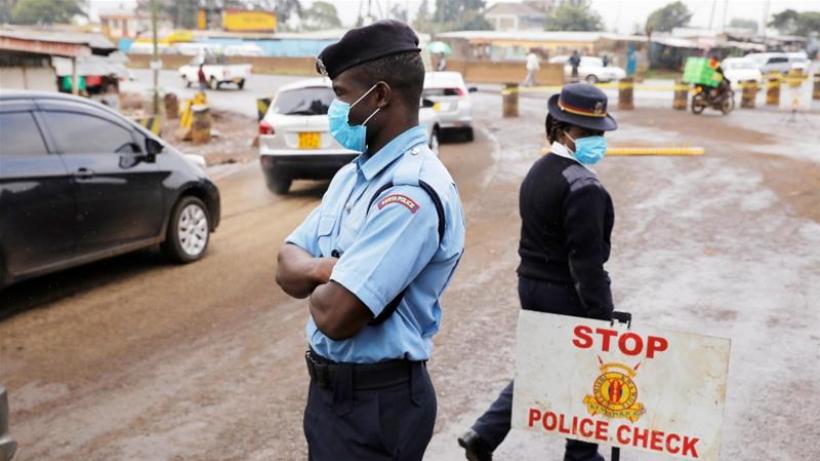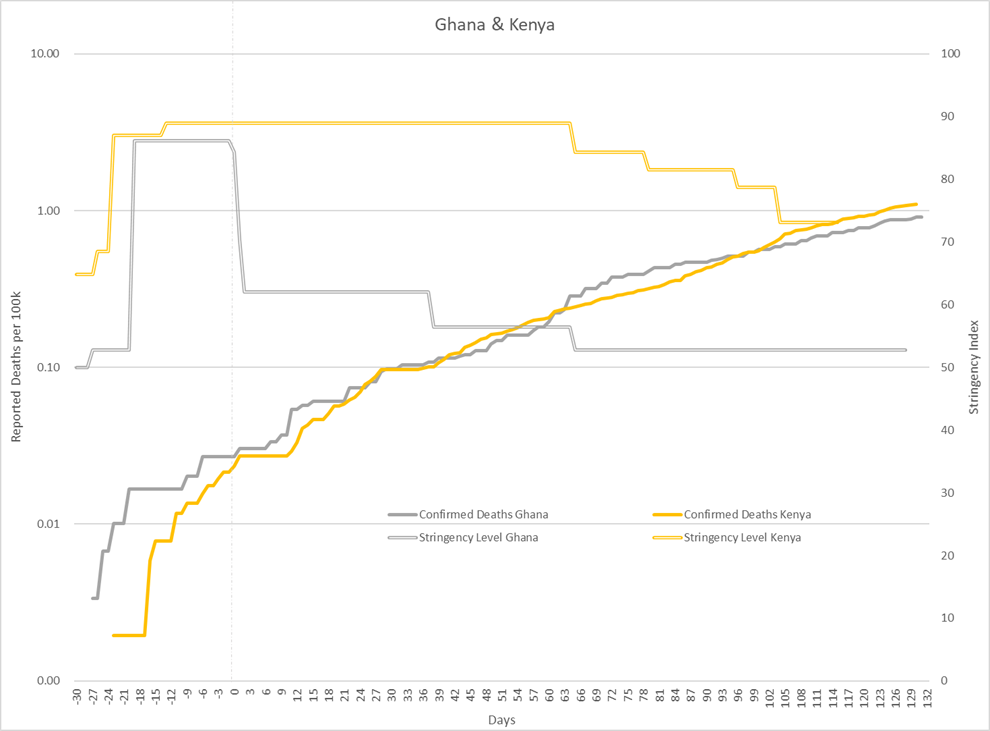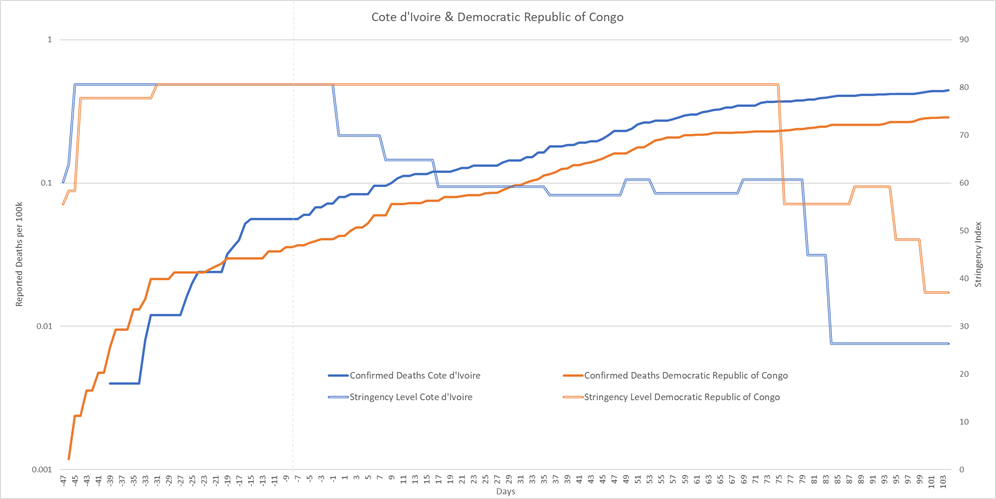
A policy trade-off? The impacts of stringent COVID-19 lockdowns
New evidence suggests more moderate virus containment measures may be as effective in saving lives as stringent lockdowns – while saving economies.
In response to the COVID-19 pandemic, more than 170 countries around the world implemented some form of lockdown by 31 March 2020. Governments had to make urgent policy decisions with limited evidence. ‘Stay at home’ limitations were imposed in 139 countries (OxCGRT, 2020). As the effects of these decisions are being realised, the efficacy of stringent lockdown policies are being re-evaluated with regards to curbing the spread of the virus and the impact on economic activity.
Comparative analysis: Lockdown policy and mortality rates
To better understand the effectiveness of stringent lockdown policies, it is important to compare countries that had similar lockdown restrictions in place - but then diverged in their approach as the pandemic progressed. One can then determine if this change in policy had an impact on the trajectory of reported deaths over time.
The Oxford COVID-19 Government Response Tracker (OxCGRT) collects data on lockdown measures and aggregates it in a ‘Stringency Index’. This data has been combined with reported cases and deaths across all low-income and lower-middle income countries to examine trends since the first case was reported in each country.
To have a comparable set, countries with less than 100 reported deaths were not included and the remaining 33 countries were compared keeping in mind the following criteria: Median population age, life expectancy, and the efficacy of the health systems to treat the sick (as reported by the Global Health Security Index on 28 August 2020).
While comparing stringency levels, only those countries were compared where the stringency levels were at the same level for more than ten days before diverging. Ghana and Kenya, as well as Cote d'Ivoire and the Democratic Republic of Congo (DRC), were identified as relevant for comparative country analysis:
Ghana versus Kenya
Ghana and Kenya - both lower-middle income countries with comparable levels of median age (20-21 years), life expectancy (62-63 years), and health systems in place - reported their first case at the same time and had similar lockdown policies in place for the first 35 days of the pandemic. This involved school closures, selective workplace closures, and restrictions on internal and international movements.
While Kenya continued with the same stringent lockdown policies in place, Ghana started easing some of the restrictions: Restrictions on staying at home and internal movement were removed, while international travel was still restricted and people were encouraged to work from home.
The findings
The figure below shows how the stringency level of both countries diverged (taken as day 1). The number of reported deaths for both countries rose at the same rate, even after day 0, and the trend was consistent for the next 130+ days.
This analysis points towards some early indications that stringent lockdowns may not necessarily be more effective in controlling the virus, and how certain containment measures - such as international travel restrictions - might be more effective in limiting the incidence of the disease.

Cote d'Ivoire versus the Democratic Republic of Congo (DRC)
Cote d'Ivoire and the DRC both reported their first case of COVID-19 within a day of each other and both had low levels of containment measures in place. Within the next 15 days, both countries drastically increased their lockdown stringency levels and imposed similar levels of restrictions for around 45 days. After this, Cote d’Ivoire gradually reduced the level of stringency by moving towards more localised measures, however, restrictions on local and international movements remained in place until later.
The findings
As the figure shows below, the increase in the reported deaths per 100 thousand for both countries is consistent, especially after their stringency levels diverge. The higher level of deaths per 100 thousand for Cote d’Ivoire can be attributed to its considerably smaller population and more widespread testing as compared to the DRC. However, other indicators - such as median age, life expectancy, and health system efficacy - are comparable for both countries.

Implications: Towards moderate and localised containment policy
While it is difficult to ascertain all the country specific economic and political factors that might affect reported deaths, this comparison shows that the curve of reported deaths does not change between countries with extreme curfews and countries with moderate levels of containment measures. While containment measures help in slowing the spread of the virus, more stringent lockdowns with curfews might not be more effective in reducing mortality. Another cross country comparison showed that full lockdowns were not associated with reduction in the number of critical cases or COVID-19 mortality rates but resulted in more recoveries while late border closures led to higher caseload in the studied countries (Chaudhry et al.,2020). There is a need to further investigate the efficacy of specific containment policies, such as stay at home, school closures, and restrictions on local and international movement to control the pandemic.
Nationwide stringent lockdowns were recommended by the World Health Organisation (WHO) at the start of the pandemic and supported by leading epidemiologists. However, countries are increasingly encountering the devastating economic and social impacts of such stringent lockdowns. Governments need to look at new ways of containing the virus while attempting to simultaneously reignite their economies. WHO policy has also seen a shift: Governments are now encouraged to avoid national lockdowns and implement more tailored containment measures to control the pandemic (Telegraph, 2020).
Conclusion: A trade-off between health and the economy?
The effect of lockdown policy is not being questioned as it inevitably reduces the incidence of the disease. The more important policy question is what are trade-offs of lockdown? Governments need to devise and implement containment measures that do not severely hinder economic activity, without significantly increasing the incidence of the virus and putting a strain on their health systems.
Disclaimer: The views expressed in this post are those of the authors based on their experience and on prior research and do not necessarily reflect the views of the IGC.

